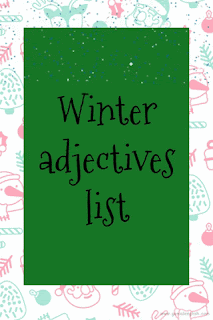Winter adjectives list
Traditionally, in the United States, December is the holiday season, observing Christmas and other celebrations as Hannukah and Kwanza.
December also marks the last month of the Gregorian calendar. People celebrate the new year On December 31st with parties and delicious dinners.
In the United States, December is known as the high buying season. People celebrating religious holidays give gifts to their loved ones to express their appreciation and good wishes for the upcoming year.
People celebrating Christmas have an important and fun tradition: looking for the Christmas tree. Usually, people visit pine tree nurseries and pick a natural tree to bring home and decorate with different ornaments and lights.
I think winter is so much fun! And we can use different words to describe what happens during this season. Such words are called adjectives.
Adjectives are a part of English speech. We use adjectives to describe how a person, place, or thing (noun) is.
If you go to the pine tree nursery looking for the perfect Christmas tree, what words can you use to describe it to the salesperson? Do you need a small tree or do you prefer a large one? Do you want it fragrant? How costly? How firm are the branches? How soft are the needles? Do you like it cut or potted? What words can you describe them? A simple form to remember them is by recalling our five senses; you can use your sight, touch, smell, taste, and hearing. Most likely, you will tell the appearance (crooked), texture (rough), size (tall), and needles texture (soft).
Here is a list of some adjectives used to describe winter. These are nouns modifiers and have a direct effect on the noun.
Scroll down to the bottom, and you will find interactive vocabulary cards!
Christmas interactive "find the difference" game.
Learn more about me! Get in touch if you are interested in my online instruction!
Visit my Teachers Pay Teachers store for more resources.
- Appearance adjectives: These adjectives engage in the sight sense. An appearance is helpful to describe how someone or something looks.
- Color Adjectives: These adjectives also engage in the sight sense. They come in handy to make more specific descriptions.
-Condition and quality Adjectives: These adjectives describe the state, situation, or working order of something or someone.
- Feeling (good) adjectives: These adjectives are helpful to describe a state of mind.
- Shape adjectives: These adjectives engage in the touch sense and/or sight; it helps identify how something looks.
- Size Adjectives: These adjectives engage in the touch sense and/or sight; it identifies the size (weight, height, width) of someone or something.
- Sound adjectives: These adjectives engage in the sense of hearing (tone, pitch, and volume). It is helpful to make detailed noun descriptions.
- Time Adjectives: These adjectives are helpful to identify the age or time of a noun. It helps us perceive if something is current or past and how quickly something or someone moves.
- Taste/ smell Adjectives: These adjectives engage in the taste sense and/or smell. It is helpful to describe if something is in good condition or not.














Comments
Post a Comment